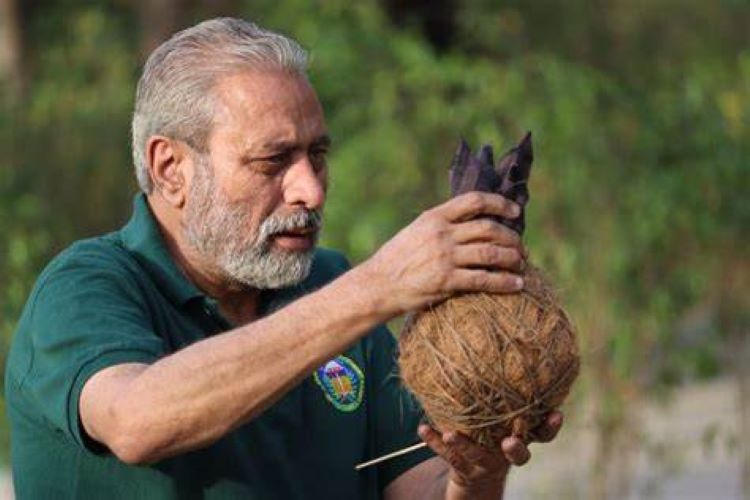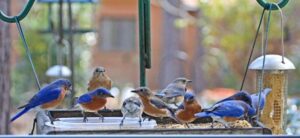Bringing birds back to your backyards is his mission

Rakesh Khatri has been working towards bringing birds back into homes
Rajkumari Sharma Tankha
Rising skylines, shrinking open spaces and dwindling green areas bothers him no end. An aftermath of this – the reducing number of sparrows, the birds he grew up watching – pains him deeply. He understands all this is the result of humans excessively eating into the spaces of birds and animals. And he is doing everything in his might to reverse this, be it holding theatre workshops on environmental issues, making birdhouses to call back the house sparrows or organize nature trails and making serials and films to educate people.
Meet Mayur Vihar (Delhi) resident Rakesh Khatri who founded Eco Roots Foundation, four years back, in 2012, to propagate the cause of maintaining ecological balance. He has a firm belief – “We do not inherit the earth from our ancestors; we borrow it from our children”.
A passionate naturalist, conscientious environmentalist, an avid film maker and a theatre activist all rolled into one, Khatri is best known for his Save The House Sparrow programme under which he reaches out to children, RWAs and corporates and trains them in techniques of making birdhouses so as to bring the little goraiya back into our backyard. So far, Save The House Sparrow workshop has been held in 1,400 schools and over 18,000 children have already been taught this technique of making environment-friendly birdhouse.
In fact, his technique of making an environment-friendly birdhouse won for him the International Green Apple Award for Environmental Best Practice for Sparrow Conservation at the House of Commons in London in 2013. “We put 100 birdhouses on the trees along the DND Flyway in March this year, and most of these have been adopted and patronized by the birds,” he says with elation.
Khatri has given his heart and soul to bring about a positive Mass Outlook Change (MOC) towards nature. “Environment is an integral part of our lives and we need to be sensitive and careful towards it. It needs to be nurtured by the inner potential of the people,” he says.
He initially started his career as a freelance photographer in Mumbai, and then graduated to making serials and documentary films. He is credited with making over 270 documentary films, a number of TV serials, and a series on Indian havelis, A Home From the Past, among others.
He entered the field of environment education in 2003, though the seed for it was sown during his visit to Sariska two decades back. He spotted a dead Sambhar calf there. Wanting to know how this young animal had died, Khatri got its post mortem done. The report revealed the presence of polythene bags entangled around its intestine that had caused its death. That was the first time Khatri realized that something should be done against plastic, but what he had no clue. While he continued with his job, the cause of young sambhar’s death stayed with him, bothering him.
In 2003, Khatri quit his job and moved to Delhi with the intention of doing something for the cause of environment. He set up an NGO with some friends, but it was closed shortly. Thereafter, he worked with a number of NGOs, and took up a number of independent projects before setting up his own NGO, Eco Roots Foundation, in 2012.
“The first big project I got as soon as I set up the foundation was from Panasonic. The work involved doing theatre workshops for children on climate change which was quite successful. We organized workshops in 240 schools located in 24 cities of 17 states under this project, in 12 languages,” he says. For this, his name also finds mention in Limca Book of Records 2013.
Soon after began his work on house sparrows. “All through my growing-up years, house sparrows have been my constant companions, but now there were none. And I thought I must do something,” he says.
Khatri decided to make birdhouses to invite the house sparrows. Initially, he made a birdhouse using used coconut shell, neem sticks and khas fibre and placed these on trees, but it was not very successful. Then he improvised further and made birdhouse using chik and jute which were quite easily adopted by birds. “Wherever I used to hold workshop, I used to teach students the technique of making these and would tell them to place the bird houses on trees. In this way, a large number of birdhouses were placed on trees in Kondli, Geeta Colony, Ashok Nagar etc, and today I notice birds have returned to these colonies,” he says. In addition to working with children, Khatri has also done a project with teachers on environment, educating 7,000 teachers across 30 states, indirectly impacting over 1.5 lakh children.
Presently, he is busy with Neer aur Naari, a project on the role of women in water conservation. It’s a Department of Science and Technology project wherein he is working with class 6-9 girls from 200 schools across 20 states. “We are working in areas where there is scarcity of water. The girls are to make stage or street plays on women who have helped conserve water in their area,” he says.
This apart, Khatri has made some environment games and riddles which he plans to share with children soon. He also uses old games like chidiya ud, chian and stapu to give messages on environment.
“Its high time we try to save our environment. I strongly feel that environment conservation has to start at the individual level. Till the time each one of us gets serious about it, nothing much can be achieved,” he says. “Unfortunately, as of now environment conservation is limited to planting trees by government and other organisations, which aren’t even looked after later,” he laments.


